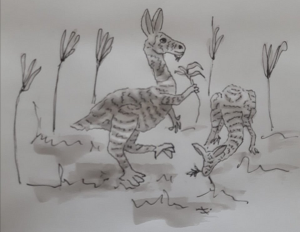Difference between revisions of "Kentar"
From World of Entorais Wiki
Jump to navigationJump to search (→Stories: link) |
m (→Description: content) |
||
| (One intermediate revision by the same user not shown) | |||
| Line 10: | Line 10: | ||
:Female - 1.7 – 2 metres (5 feet 7 inches - 6 feet, 7 inches), 120 kilograms (265 pounds) | :Female - 1.7 – 2 metres (5 feet 7 inches - 6 feet, 7 inches), 120 kilograms (265 pounds) | ||
;Appearance:Physically kentar resemble antelope headed ostriches or other large flightless bird. They have smooth, short haired hide, and a pair of small fore-limbs ending in dexterous long fingered paws, with a semi-opposable 'thumb'. | ;Appearance:Physically kentar resemble antelope headed ostriches or other large flightless bird. They have smooth, short haired hide, and a pair of small fore-limbs ending in dexterous long fingered paws, with a semi-opposable 'thumb'. | ||
;Sexual dimorphism:Male kentar are slightly larger than females, and have a short crest of stiff hairs along the spine of their necks. | ;Sexual dimorphism:Male kentar are slightly larger than females, and have a short crest of stiff hairs along the spine of their necks, and a small beard of longer hairs at their chins.. | ||
;Variance:Kentar can have a wide range of coat patterns (stripes, spots, blotches, mixed, or piebald) and colours (generally white through black, and a full range of light and dark browns.) | ;Variance:Kentar can have a wide range of coat patterns (stripes, spots, blotches, mixed, or piebald) and colours (generally white through black, and a full range of light and dark browns.) | ||
| Line 18: | Line 18: | ||
==Behaviour== | ==Behaviour== | ||
;Social grouping:In the wild Kentar | ;Social grouping:In the wild Kentar form herds upwards of one hundred animals, but tend to form familial subgroups of a dozen or so animals. | ||
;Temperament:Alert and skittish towards unfamiliar creatures or events in their environment. | ;Temperament:Alert and skittish towards unfamiliar creatures or events in their environment. | ||
;Intelligence:Kentar are quite clever as animals go, and capable problem solvers. | ;Intelligence:Kentar are quite clever as animals go, and capable problem solvers. | ||
Latest revision as of 16:53, 18 October 2022
About
- Common Names
- Kentar
- A bipedal mammal found in prairie, steppe, and other grassland areas of Entorais.
Description
- Classification
- mammal
- Size (adults)
- Male - 2.1 – 2.8 metres (7 feet, 1 inch - 9 feet, 2 inches), 150 kilograms (330 pounds)
- Female - 1.7 – 2 metres (5 feet 7 inches - 6 feet, 7 inches), 120 kilograms (265 pounds)
- Appearance
- Physically kentar resemble antelope headed ostriches or other large flightless bird. They have smooth, short haired hide, and a pair of small fore-limbs ending in dexterous long fingered paws, with a semi-opposable 'thumb'.
- Sexual dimorphism
- Male kentar are slightly larger than females, and have a short crest of stiff hairs along the spine of their necks, and a small beard of longer hairs at their chins..
- Variance
- Kentar can have a wide range of coat patterns (stripes, spots, blotches, mixed, or piebald) and colours (generally white through black, and a full range of light and dark browns.)
Ecology
- Habitat
- Kentar favour open grasslands or savanna.
- Diet
- As ruminant herbivores they graze on the wild prairie grasses and similar plants. They can eat a variety of grasses, bark and leaves from shrubs, roots, fruits and vegetables.
Behaviour
- Social grouping
- In the wild Kentar form herds upwards of one hundred animals, but tend to form familial subgroups of a dozen or so animals.
- Temperament
- Alert and skittish towards unfamiliar creatures or events in their environment.
- Intelligence
- Kentar are quite clever as animals go, and capable problem solvers.
- Reproduction
- Kentar males compete for access to females, and mate in the autumn. One or two young are live birthed in the spring, and reach sexual maturity at two and a half years.
Domestication
- General
- These creatures are exceptional problem solvers and can figure out many latches and the like making it difficult to keep them corralled.
- Some tribes of the Tak-Mi-Lah and Anatu have domesticated these beasts instead of wild horses, and do use them for riding.
- Mounts
- As mounts they do not have the strength of a horse, but are incredibly fast, and agile runners, with a similar stamina.
- Most Treahni do not see much value in raising and domesticating these beasts, as the challenge of dealing with precocious strays makes them less desirable.
- Those who have them as mounts claim to have a stronger mount and rider bond than most horsemen.
- Resources
- Milk, meat, and leather.
Stories
See Also
- Garin (kentar rider of the Anatu)
